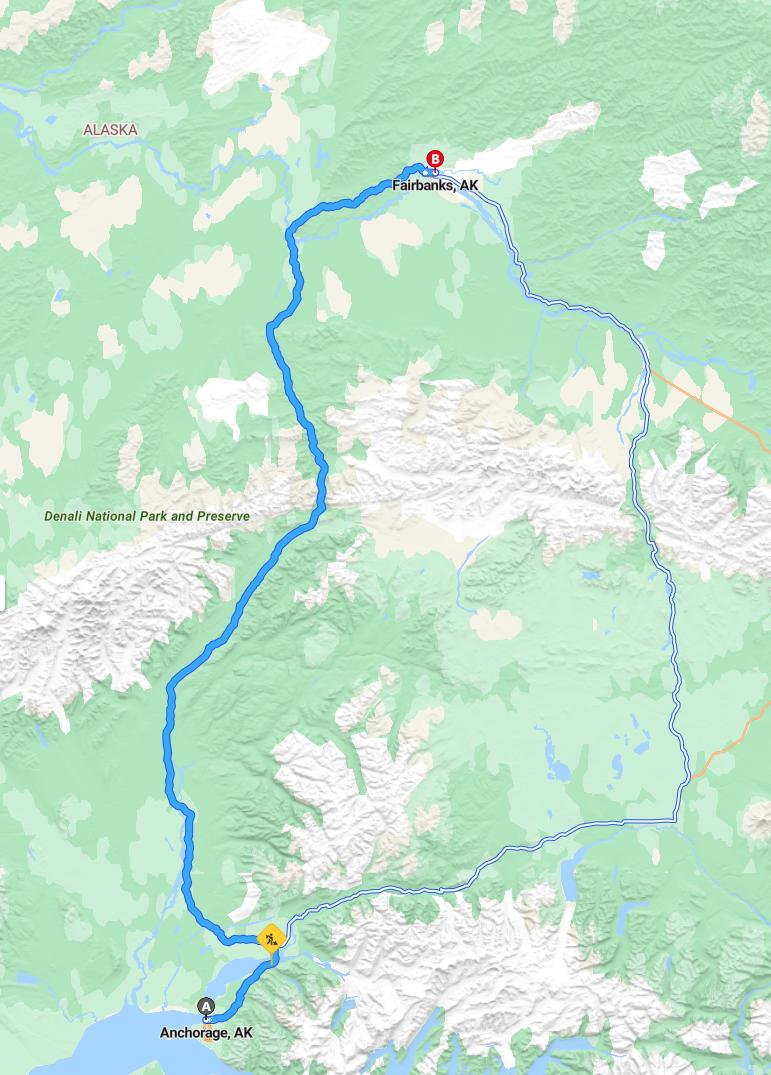Distance and estimated driving time
The drive from Anchorage to Fairbanks covers approximately 358 miles via AK-3. This trip typically takes around 6 hours under normal driving conditions, providing travelers ample time to enjoy the scenic Alaskan landscape. The route offers a relatively straightforward journey, making it a manageable transfer between these two major cities. Planning ahead can ensure a smooth trip, whether for leisure or business purposes.
Driving route
The scenic drive from Anchorage to Fairbanks offers travelers a diverse glimpse of Alaska's breathtaking landscapes. Beginning in Anchorage, visitors can enjoy urban amenities before heading north towards the wilderness. A highlight en route is Denali National Park and Preserve, renowned for its majestic mountain, abundant wildlife, and pristine wilderness. This stop provides an opportunity to explore incredible hiking trails, scenic viewpoints, and educational visitor centers. Continuing the journey, travelers arrive in Fairbanks, a vibrant city known for its rich Alaskan history, arts scene, and as a gateway for viewing the Northern Lights during winter months.

Road conditions and seasonal considerations
Driving from Anchorage to Fairbanks offers stunning views along a route that includes Denali National Park and Preserve. During this journey, road conditions can vary significantly depending on the season; in winter, icy and snow-packed roads require careful driving and sometimes chain requirements, while summer typically provides dry, more navigable conditions. With substantial seasonal changes, travelers should stay updated on weather forecasts and road advisories, especially in winter months when storms can cause closures or dangerous driving conditions. Proper preparation, including vehicle readiness and awareness of seasonal variations, ensures a safe and enjoyable trip through Alaska's impressive landscapes.
Top attractions along the route
Traveling from Anchorage to Fairbanks offers an exciting journey through some of Alaska's most iconic sites. En route, visitors can explore Denali National Park and Preserve, home to North America's tallest peak, Denali, and abundant wildlife viewing opportunities. The scenic drive also provides breathtaking landscapes, with expansive forests, mountain vistas, and possibly glimpses of wildlife such as moose and grizzlies. Upon reaching Fairbanks, you can enjoy attractions like the Museum of the North and the opportunity to witness the mesmerizing Northern Lights during the winter months.
Recommended travel gear and safety tips
When driving from Anchorage to Fairbanks, it's essential to pack appropriate travel gear such as warm clothing, waterproof layers, and sturdy footwear to prepare for variable weather conditions. Carrying an emergency kit, including a first aid kit, flashlight, extra blankets, and chains for your tires, enhances safety during remote stretches like Denali National Park. Always check road conditions and weather updates before departure, and inform someone of your route and expected arrival time. Additionally, ensure your vehicle is in good condition, with a full tank of gas, to avoid unforeseen breakdowns in this scenic but sometimes isolated region.
Lodging options in Fairbanks
Fairbanks offers a variety of lodging options to suit different preferences and budgets. Visitors can choose from upscale hotels such as The SpringHill Suites by Marriott and Westmark Fairbanks Hotel & Conference Center, which provide comfortable amenities and convenient locations. For a more rustic experience, numerous bed and breakfasts and cozy motels are available, offering a warm and welcoming atmosphere. Additionally, there are RV parks and campgrounds for travelers interested in outdoor accommodations, allowing for an immersive Alaskan experience near the wilderness.
Fuel and rest stop locations
When driving from Anchorage to Fairbanks, it is important to plan for fuel and rest stops along the route, which includes key locations like Denali National Park and Preserve. There are several fuel stations available in Anchorage and Fairbanks, providing convenient options before departing or upon arrival. Along the way, travelers can find rest stops and service areas near strategic points such as the park entrance and in smaller communities to ensure a safe and comfortable journey. Planning these stops in advance can help maximize your time for sightseeing, while ensuring you have enough fuel for the drive through the scenic Alaskan landscape.
Weather forecast for the travel period
The weather forecast for the driving period between Anchorage and Fairbanks highlights generally cold temperatures, with potential for snow and icy road conditions, especially near Denali National Park and Preserve. Travelers should prepare for variable weather, including possible snowstorms or snow showers that could impact visibility and driving safety. It is advisable to check real-time weather updates and road condition reports prior to departure, and to carry appropriate winter gear such as tire chains and warm clothing. Overall, travelers can expect typical winter conditions for interior Alaska, emphasizing the need for cautious driving and thorough planning.
Local dining options en route
Traveling from Anchorage to Fairbanks via Denali National Park offers unique dining experiences along the route. In Anchorage, visitors can enjoy a variety of restaurants serving fresh seafood, locally sourced ingredients, and regional specialties. Near Denali National Park, options are more limited but include cozy cafes and lodges offering hearty, comfort foods perfect after exploring the park's stunning landscapes. Once in Fairbanks, a vibrant food scene awaits with everything from Asian fusion to traditional Alaskan fare, ensuring travelers can satisfy their appetites after a day of adventure.
Wildlife viewing opportunities during the drive
Embarking on the drive from Anchorage to Fairbanks offers exceptional wildlife viewing opportunities, particularly in Denali National Park and Preserve. Travelers may encounter majestic moose grazing near the road, herds of caribou migrating across the tundra, and the elusive Dall sheep navigating rocky slopes. Birdwatchers can also enjoy spotting bald eagles soaring overhead and ptarmigans blending into the landscape. This scenic route provides a rich, immersive experience for wildlife enthusiasts eager to observe Alaska's diverse fauna in their natural habitats.
